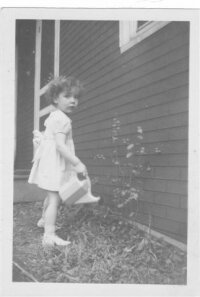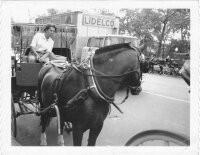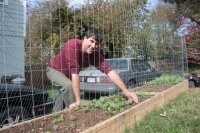Recycling history: Modern 'green' scene not so modern

For one thing, our parents were naturally green because they were children of the Depression and, for the most part, also children of the defeated, depleted post-Civil War South. Lee's North Carolina-born mother (whose father helped found the Scottish Bank of NC – complete with tartan-lined mailing envelopes and penny-pinching ways) and Kenya-born (of missionary parents from Canada and Northern Ireland) father, lived a self-sufficient existence in rural Pennsylvania when he was born and his dad was on the University of Pennsylvania faculty. And my parents– whose Charlottesville roots went back to the mid-19th century– were of necessity savers and reusers.
Everybody was "dog poor," an aunt of my mother wrote of her growing-up years.
I remember my mother suffered lifelong pain from reflexive recycling of shoes. In her family, they were handed down by age, not by foot size. Unfortunately, her feet were bigger than those of her two older sisters. So by the time she was an adult, she had bunions and bone spurs and other such problems that plagued her to the end of her days.
I remember my mother coming back from a talk at the Blue Ridge Sanitarium by a Jordanian refugee. The speaker had lamented Americans' waste of paper, saying how valuable every scrap had been when he was growing up in post-WWII Palestine. From that I developed a lifelong habit of– instead of using new paper– writing notes, letters, etc. on the backs of documents others would have trashed.
At about the same time I learned lessons about charity, dignity, and related subjects. My mother's First Baptist Sunday School class regularly held rummage sales where prices often fell so low many might consider them as no price at all. But my mother explained to me why charging even a little bit for something made it much more valuable than giving it away and making the recipient feel like a charity case.
Once she told me about an obviously very poor woman who'd spent a great deal of time deliberating over a really nice winter coat priced at 50 cents. My mother watched for a while, then went over and told the woman that because the sale would be closing in an hour, the coat price was reduced to 25 cents. The woman lit up, she said, and paid the quarter, obviously feeling as though she was the smartest– and warmest– shopper in the world.

Even before Lee and I had property of our own– we bought 406 Oak Street in 1987– we began to practice not just reusing and recycling but "pre-cycling"– which is to say, not buying anything that was overpackaged if we could possibly avoid it.
We started a compost heap in '87. Anything organic that we couldn't dispose of otherwise– by eating, by making stock, by burning in our highly efficient little woodstove– has gone there. And the resulting compost has gone on plants.

On balance, though, I have to believe that even the darkest of the Industrial Revolution's "dark Satanic mills" did minor environmental mischief compared to modern lifestyles that promote world-class waste and abuse on a minute-to-minute basis.
As for the modern "green" scene, I find it sickeningly hypocritical in the extreme. Putting a sedum roof on and "bird-friendly" glass windows in a behemoth of a building cannot by any stretch of the imagination be construed as "green" if construction of said building begins by clear-cutting more than an acre of trees, piping a stream, and gouging a steep slope.
How many ways do we behave greenly– and, it would appear, frugally at the same time? Here are a few in no particular order:
~~We plant a great deal. Therefore, we need a lot of mulch. On rare occasion, we've bought shredded bark or something similar. Mostly, we pick up City-offered detritus for free. Indeed, every year we drive our ancient, 250,000-mile-plus pickup truck around the City on the Sundays before official leaf pickups and take home the best looking bags we can find of leaves others have raked for disposal. And we've also gleaned fallen straw at Southern States– with management permission, of course– to bulk up compost piles. Also, much of what we plant is found stuff– volunteers on our own property, seedlings that would be mowed or weeded from public property, stuff discarded by others.
~~We don't waste food. We think and make lists before buying. We wash, core, trim, crisp, etc., what we buy and store it properly to give it the longest possible useful life. And if we can't use something in the way we first intended (like as a main dish), then we use it another way (like as an ingredient in a stock).
~~We walk. Lee drives to work at Monticello daily. I drive to Harris-Teeter or Whole Foods once a week. When we have to, we make a special run to Sneak Reviews or the dentist or whatever. Otherwise, we walk.
~~We're super stingy with water. What's left in the tea kettle, salad spinner, whatever, goes into a watering can for redeployment on plants or in the bird bath. Boiling water from pasta cooking goes on driveway weeds as an instant organic herbicide. We have a little clothes washer with wheels that hooks up to the kitchen sink. In growing season, we capture the rinse and distribute it to plants. We also capture rainwater in containers for redistribution.
~~We keep electricity use down. We make a point of seeing that all vampire appliances are unplugged when we aren't using them. We have a portable clothes dryer to go with our little washer. To minimize its run time, we start clothes drying on racks. And once we've started the machine, we stop it frequently to empty the filter. Things dry much faster if that's done. After doing our best to live without air conditioners for years, we finally gave in because City heat was rising. So we have two small high-efficiency units in upstairs north-facing windows, which means that we take advantage of the Venturi effect. And we also use pieces of Reflectix insulation (meant for attics and crawl spaces) as easily cut-to-fit window coverings to deflect sun before it can get inside and heat up the house.
~~We shop second (or third or fouth) hand– a habit that started with my mother's regular visits to the Opportunity Shop. With negligible exception, everything we wear and most of what we use comes from thrift shops. We get our best finds from FanTastic Thrift and The Coat Rack (the Junior League shop) in Richmond and from Twice Is Nice and SPCA Rummage here. We also pick up the occasional bargain at the Salvation Army and Goodwill shops here and in Richmond. And we've bought a number of items at Habit for Humanity shops here and in Richmond and Staunton and also picked up eminently useful items at the Blue Ridge Home Builders' annual yard sales. Plus, I'm an avid dumpster diver and picker of what others leave on the streets.
–Oh, did you know that prior to the 1870s and '80s, when wood pulp milling expanded exponentially, newspapers regularly ran house ads for rags? They needed them to make paper for more newspapers. And, of course, that's why many early papers are much better preserved than much later papers. Highly acidic wood-fiber paper turns to dust apalingly fast while rag-based paper can last close to forever. A practice worth reviving maybe?
Antoinette Roades is a Charlottesville writer, editor, historian, and local preservationist who, for as long as we can remember, has never been shy about making her views known.
1 comment
While in the same house for 20 plus years I have reduced electricity use to less than half of what it was by use of simple expedients that include compact fluorescent light bulbs everywhere, hanging clothes to dry, taking shorter showers, and (this is the biggest of all) turning AC way up during the day to 80+ and dropping it down to 72 at night and using ceiling fans. Before I would leave it at 70 all the time and lower it at night. Dominion Va. Power sends out those periodic mailings comparing my electric use to that of my neighbors and I blow them out of the water. As for heating fuel, I heat up the house a bit while doing my morning routine and cut it way back when I leave the house. At night I find the low to mid fifties is just great for sleeping under lots of blankets. By so doing I have cut the quantity, if not the cost, of my heating fuel use down to about 60% of what it used to be in the eighties. Abandoning the foolishness of thinking it's a precondition of civilized life that one by able to run around the house all winter in "barefoot comfort" ( an actual advertising expression used by the heating business in time past), has kept me comfortable at 62 during the days when I'm home, thanks to wool slippers and sweaters. I do all this even though I am easily able to afford profligacy and I do it because it just seems right.
Cars are another matter; I live in the 'burbs and have to commute, but the difference between a car that averages 16 and one that averages 25 is huge.
During WW2 people were encouraged to heat no higher than 68 in the day and 55 at night. It was strategic since WW2 was won not so much by valor as through the winning sides having more petrol than the others, but those heating numbers remain a good standard that's easy to live with. My parents who were depression children used their thermostat that way throughout my childhood and continued to do so right up to their deaths.